The Inkey List are a brand that I generally quite like (well not anymore, now that I’ve seen their response to me raising this issue, and some of their other practices). They’re probably the main competitor to The Ordinary, which I also quite like.
Both brands have lots of products, and many of them work well on my skin. They’re both also really budget friendly, and it’s hard to hate brands that are making skin care more financially accessible! Both brands are also quite science-focused in their marketing. They put their ingredient names front and center and i think that’s gone a long way towards making everyone more comfortable with using synthetic chemicals that they might not be able to pronounce very easily they have sort of scary-ish names the whole natural is better don’t use ingredients you can’t pronounce thing i think really took a blow thanks to these brands
Recently The Inkey List released a new product, the Succinic Acid Acne Treatment. You’ve probably seen it all over social media – Inkey are really busting out the marketing budget for this release! And honestly, I like this product a lot. It’s been working really well for breakouts I’ve gotten, and seems to calm them down overnight. But I’m finding the marketing around this product kind of shady, and I’m going to explain why.
First off, this is not a bad product. It works well on me, and I think there are very few truly bad products on the market. But there is a LOT of dodgy marketing.
I’ve been blogging about beauty products since 2011, so I’ve had a lot of time to read press releases about new products, and I’ve gotten used to the sorts of marketing tricks that brands use. I’m not sure if it’s intentional, but the marketing around The Inkey List Succinic Acid Acne Treatment is… kind of genius.
The video is here on YouTube, keep scrolling for the text version…
What’s the evidence for succinic acid?
Peer reviewed studies
Let’s start by talking about succinic acid. Succinic acid is usually used as a pH adjuster or chelating agent in products, so it’s playing a supporting role and isn’t really comsidered an active ingredient that benefits skin directly. There are almost no peer-reviewed studies on it for acne.
There are two papers on PubMed where succinic acid and acne are both mentioned. Both are from the same research group, and only the 2014 one looks specifically at succinic acid.
The background is that Staphylococcus epidermidis bacteria compete with C acnes bacteria on your skin. Neither of them are really good or bad: they both contribute to acne, but they both also protect your skin against infections from other microbes. They both live inside acne pimples, and they’re competing with each other. Succinic acid is one of the chemicals that the Staph bacteria might be using to keep the C acnes bacteria in check.
To explore this, the researchers put succinic acid with C acnes bacteria on a multi-well plate. They found that they needed a 5 mM concentration to kill the bacteria. (For comparison they needed twice as much lactic acid (10 mM), and 50% more acetic acid (7.5 mM) – acetic acid is the acid in vinegar.)
Next, they injected C acnes bacteria into mouse ears to make them inflamed, like acne would be. Then they injected succinic acid into them and they found that both the number of bacteria and the inflammation decreased. Finally they decided to, um, skincare some mouse ears. They injected the C acnes bacteria into more mouse ears, then applied about 1% succinic acid onto them. Again, they found that the bacteria counts and inflammation decreased.
Now, this is pretty promising, but far from enough evidence to say that it actually works against acne, as a drug ingredient. In medicinal chemistry, there are millions and millions of compounds that work well on cells and on animals, but never become drugs. Things that work well in cells and animals don’t necessarily work well on humans in real life. The conditions on your skin are very different from the conditions on glass or on an animal.
That’s why you read about cures for cancer being found in Amazon rainforests, and never hear about them again. It’s not because Big Pharma is suppressing the information – it’s because that headline is based on in vitro or animal studies, and it wasn’t actually tested on humans. That’s why the “Just Says In Mice” Twitter account exists.
Supplier info
There’s also data from the chemical company that sells succinic acid to brands showing that it decreases sebum. But there are basically no details on how the study was done, and a lot of supplier studies are pretty low quality, with really small sample sizes. Sometimes the protocols are a bit rigged in the ingredient’s favour. So that doesn’t tell us much.
“European medical circles”?
The Inkey List marketing material also says that “succinic acid has been in European medical circles for a while”. This has been repeated in a lot of magazines, but it’s a really ambiguous statement, and I haven’t heard back from The Inkey List about what that actually means.
I don’t think it means that it’s being used by European doctors to treat their patients for acne – I’ve asked a few dermatologists who’ve never heard of it, and we saw the complete lack of evidence before in the Pubmed search results.
Drug status and fluff ingredients
So with this evidence base, it isn’t really surprising that no one’s heard of succinic acid before. Clearly no big brands are excited enough about it to put it as the star ingredient in their products. A lot of ingredient checker sites don’t even have a listing for it. Inkey have chosen an ingredient that they pretty much have a monopoly on.
This is nothing new. A lot of brands choose to use ingredients that no one else is using – for the novelty factor, or to get people excited about the exclusivity.
And putting ingredients into products that don’t have a lot of evidence behind them is, again, nothing new. It happens all the time, and in general I think it’s a good thing – if everything had to be tested properly, then we would all be using about three products.
Related post: Science vs Anecdotal Evidence and Reviews (with video)
To me, one of the big differences here is that the Succinic Acid Acne Treatment is actually regulated as a drug in the US. if you turn the packaging over, you can see the Drug Facts label. That’s why Inkey are allowed to have the word “acne” in the name of their product. Acne is a medical condition, and only drug products are allowed to make claims about treating medical conditions.
So the Succinic Acid Acne Treatment is an over-the-counter drug, just like sunscreen. You don’t need a prescription to buy it ,but it has a special status, because it contains an ingredient that’s been scientifically vetted to work against acne. And that ingredient is…
Salicylic acid. Which is mentioned in the corner, in size 4 font:

On the legally required Drug Facts label, salicylic acid is in the top “Active Ingredients” box:
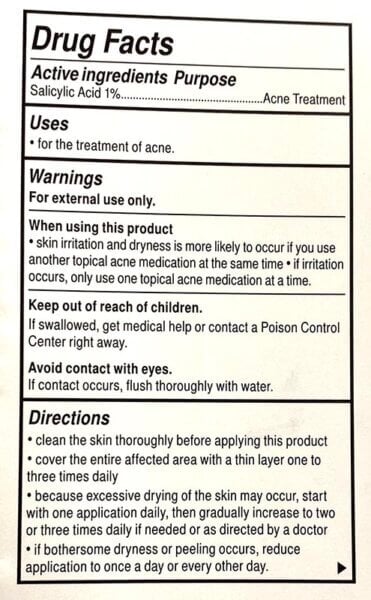
…whereas succinic acid is listed under “inactive ingredients”:
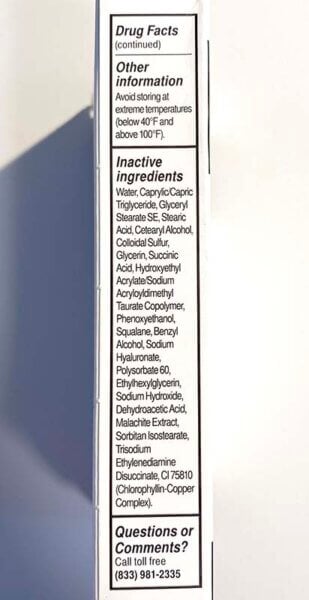
But you wouldn’t know it, if you’re looking at:
- the product name
- the product packaging
- the description of the product
- all the marketing around the product
- how everyone is talking about it, whether it’s the beauty media, sponsored influencers or unsponsored influencers
Succinic acid is always talked about like it’s the top active ingredient that’s treating the acne, and not the actual active ingredient. It’s called the “lead ingredient”, salicylic acid is “supporting”.
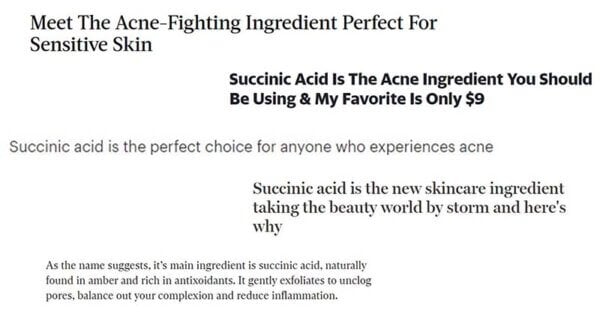
This sort of marketing around fluff ingredients is a pretty stock-standard Misleading Beauty Marketing 101 tactic that you learn about the moment you start diving into skincare. It’s where brands put a tiny sprinkle of Exotic Jamaican Sparkle Flower into their product as the star ingredient, then you flip over the pack and it turns out it’s full of retinol.
But it doesn’t happen a lot with actual skin care drugs – perhaps because people realise that this would be pretty deceptive.
It’s like a drug claiming it’s a herbal painkiller, and you flip it over and it actually has codeine in it. Or if you have a sunscreen that calls itself a mineral sunscreen, and then in size 4 font it has oxybenzone and avobenzone.
That analogy actually doesn’t work that well, because at least zinc oxide is an actual approved sunscreen filter… so instead, let’s use raspberry oil as our example. There are lots of people who genuinely think that raspberry oil is a good sunscreen, because in one in vitro study with a non-standard protocol, it came out with an SPF of 28 to 50. (To be fair, the study itself was fine, but the way it was worded could definitely lead casual readers to think that the sun protection could be directly translated to how it works on skin – one of the downsides to “doing your own research”.)
So it’s like a sunscreen that calls itself a raspberry oil sunscreen, but it also has standard amounts of oxybenzone and avobenzone in it. On the front, the oxybenzone and avobenzone are mentioned in size 4 font:
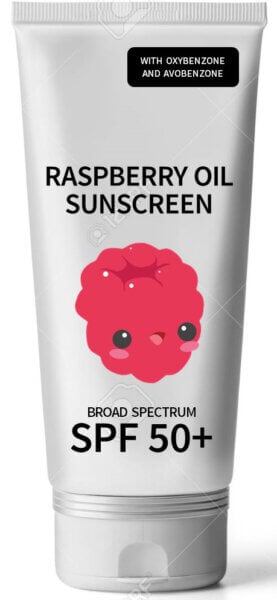
But the marketing is all about how amazing raspberry oil is for sun protection. It’s “the next big thing”, and lots of doctors in Europe have been using it for decades.
And then it says there are also these “supporting players” avobenzone and oxybenzone.
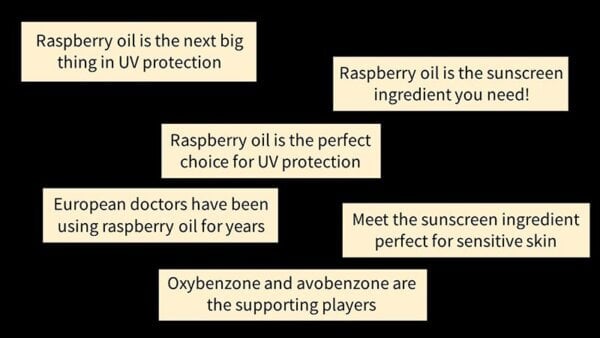
Now, Inkey may genuinely believe that succinic acid is amazing for acne, and it is the star player. And maybe it is the star player. But the level of evidence for succinic acid doesn’t let them say this, and they’re not legally allowed to say this either. It’s a pretty interesting ingredient, but with no peer reviewed studies that have actually used it on human skin, it’s pretty dodgy that it’s being marketed like it’s a drug.
For comparison, this is less evidence than a lot of ingredients that are usually considered sort of fluffy, like bakuchiol and snail slime, which actually have multiple peer-reviewed studies on human skin.
If Inkey wanted to legitimately promote succinic acid this way, they should be submitting succinic acid for proper drug approval. This involves rigorous trials on human skin, as opposed to 10 mouse ears. Then succinic acid can join salicylic acid in the top “active ingredients” box.
But obviously this is very expensive, and they already have a loophole. They don’t have to go through drug approval because everyone’s already assuming that succinic acid is a drug that’s actively treating acne. “Succinic acid” is on the packaging right next to the word “acne” – it’s impossible to miss.
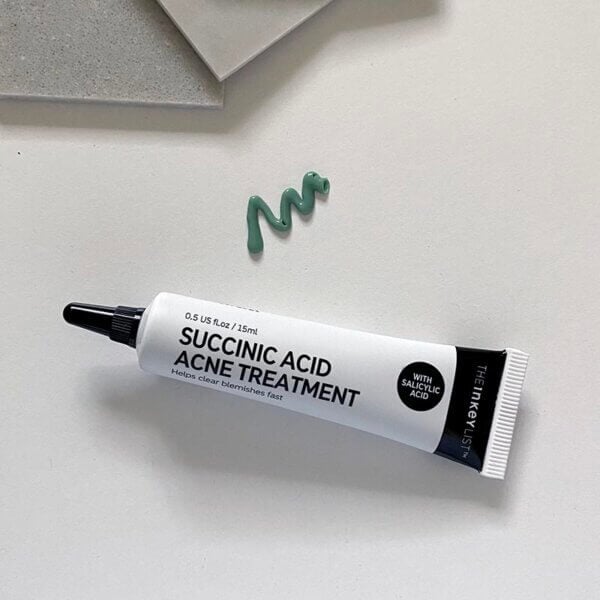
And you can see that this marketing is working really well. If you look at articles in the beauty media, succinic acid is “the acne ingredient you should be using”. But succinic acid is not an acne ingredient. This specific product is an acne treatment (because it has salicylic acid in a quantity that’s recognised as therapeutic), but that doesn’t mean all of the ingredients in it are acne ingredients. They don’t meet the level of evidence for that. That’s why they’re listed in the bottom box, with the label “inactive ingredients”.
(Of course, brands have no direct control over what the beauty media writes and what unsponsored influencers say, but they’re all working off the press release and other marketing material that the brand has issued – if there’s one overwhelming interpretation of an ambiguous statement, I think it’s reasonable to assume that the brand intends for it to come across that way. And brands approve sponsored content before it’s published.)
Why highlight succinic acid?
I wouldn’t be anywhere near as annoyed if Inkey just changed the product name and marketing so that salicylic acid was less of an afterthought. Let’s say they called it the Triple threat Acne Treatment with salicylic acid, succinic acid and sulfur. Not all of their products have a single ingredient in the name so why didn’t they do that?

Maybe they wanted to highlight how great they think succinic acid is, but maybe it’s actually the cleverest part of this…
At the moment, Inkey have a virtual monopoly on succinic acid in skincare. Almost no one else uses it as their star ingredient, and no one snuck it into a drug product with a different active drug ingredient.
The way this has played out is: people hear that succinic acid is great for acne, they google it, and conveniently the only product that’s made for acne with succinic acid is The Inkey List’s product. If Inkey used salicylic acid as the headline ingredient, then your Google search would come up with tons and tons of products from different brands. But because no one else is using succinic acid this way, Inkey have made sure that all of this traffic searching for succinic acid and acne ends up with this product, even if it ends up promoting misinformation.
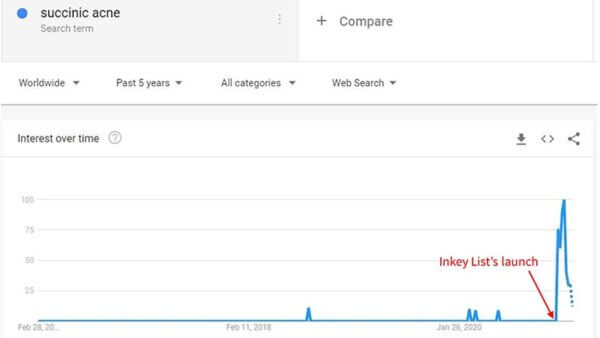
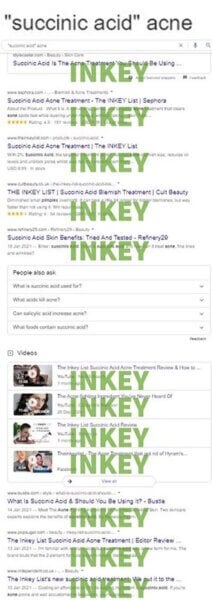
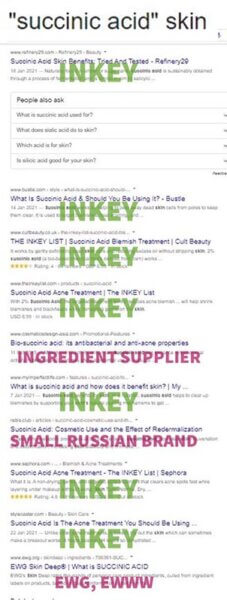
I don’t know if Inkey are marketing geniuses, or they accidentally stumbled onto this strategy, but it is working really well.
Step 1: Make a product that’s classified as a drug because of well-tested ingredients that every other brand is already using
Step 2: Put the medical condition in the name of the product next to a little-known ingredient (the less evidence for it the better, because you’ll have a search monopoly)
Step 3: Promote the crap out of the product. You barely have to exaggerate because the product name does it for you. Every media outlet or influencer who talks about the product has to say its name, and that ingrains that relationship between the ingredient and the medical condition in everyone’s minds
Step 4: Profit!
I suspect a lot of brands are going to try to copy this because it is working so well for Inkey. That’s why I decided to write this blog post and video about it, even though i realised it might be a bit controversial – so we can spot brands doing this in the future, and call them out. Again, I don’t know if this was actually Inkey’s intention. But the net effect is that everyone is being led to believe that succinic acid is an evidence-backed ingredient for treating acne – that it’s an actual drug that treats a medical condition effectively.
And for me, the worst part is that I really like The Inkey List! I really resonate with their values, and I love their emphasis on knowledge and education. And the product is a perfectly good product. It seems to work really well, and everyone is giving it glowing reviews. It didn’t need this.

Conclusion
This is a good product, but it has bad marketing. It’s misleading – perhaps it’s not intentionally deceptive, but that is the overall effect. And it feels especially bad since it comes from a brand that says it wants to educate consumers.
What do you think about The Inkey List? What about this specific product and its marketing?
This product was provided for editorial consideration, which did not affect my opinion. This post also contains affiliate links – if you decide to click through and support Lab Muffin financially (at no extra cost to you), thank you! For more information, see Disclosure Policy.
References
Wang Y, Kuo S, Shu M, et al. Staphylococcus epidermidis in the human skin microbiome mediates fermentation to inhibit the growth of Propionibacterium acnes: implications of probiotics in acne vulgaris. Appl Microbiol Biotechnol. 2014;98(1):411-424. doi:10.1007/s00253-013-5394-8




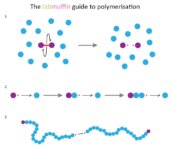

Thank you VERY MUCH for bringing this issue out!
This was the very thing that made me suspicious of succinic acid being a “real” active.
Unfortunately, I don’t think that this was an unintentional action: I personally see the same issues with their Tranexamic acid night treatment and their new “brightening” cleanser.
Welp. They had me fooled! Thanks for bringing this to light.
I think I like the product tho. I do wonder though if it’s ok to use it on a daily basis, I guess so? I’m just trying hard not to disrupt my skin too much. I want it to help with breakouts, but I don’t want it to cause them either by disrupting my PH or too much exfoliation or drying it out … if that makes sense. I’m trying to combat maskne.
You know, I was absolutely willing to give this a try (you never know! different things work for different skin!) despite the obvious BS and despite the fact that I’ve never had impressive results with any kind of salicylic acid formulation … until I saw stearic acid in the ingredients, which is a major MAAAAJOR cystic breakout trigger for me. :/
Thanks so much for picking all of this apart. Skincare companies need to know that we are ON to their doublespeak garbage, and that just putting actives front and center is not the same as “simplicity and transparency.”
How dare they indeed – they were my favorite brand out of all of them.
Thank you for acknowledging that putting ingredients that don’t necessarily have a lot of studies done on them isn’t really a bad thing in general. There are so many skincare people (for lack of a better word) that just throws out any ingredient that doesn’t have a hundred peer reviewed articles backing it. I understand the temptation and I’m all for being smart with ingredients/products but I also do think that it’s fun to have less studied ingredients in products. I like the novelty factor and maybe it’s because I used to work in a natural product chemistry lab but the idea of a new promising compound is always exciting to me!
Also, I’m starting to find that the online skincare community is becoming a bit dull and an echo chamber because there are only like 5 products and ingredients that are “approved”. Idk. It’s not as fun anymore.
The INKEY List has been pseudo. I remember their Retinol Serum is 1% RetiStar (which should be calculated about 0.05% retinol) but they market it as 1% retinol. Not sure about the background of the two founders, perhaps not chemist, without the heart for skin, merely want to fly with the trend of The Ordinary and earn alongside.
100% that some company right is having a meeting right now on how to make this Raspberry Sunscreen happen
After I ordered the three new products. I also think the direction they are going is feeling a bit desperate, i almost feel that I was coerced to order, to then find out the star ingredients have no real background info or are not actives. The live uber-influencer launch marathon was a desperate misguided disaster. The spot treatment is actually fine. The fluvic facewash feels good, but I have not really noticed a difference. The starbright – or whatever it is called – moisturiser is more creamy than gel-like. They have some great products, mostly with terrible screw top packaging that leaks everywhere, and some real duds like the dreadful apple cider vinegar peel. It is great that they are launching new products, but us commited customers really don’t deserve how false this last marketing campaign was executed. Love from Barcelona!
Thank you for making us better consumers.
Thank you so much for a great, well-written, important piece! (Thank you also for calling it a “blog post” rather than a “blog” — that usage drives me up the wall.) And on a side note, I sure hope when a company calls something a “mineral sunscreen” they’re not also adding chemical sunscreens, because I’m allergic, dang it, and they’re hard enough to avoid as it it.